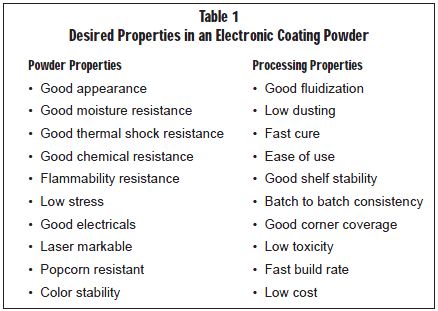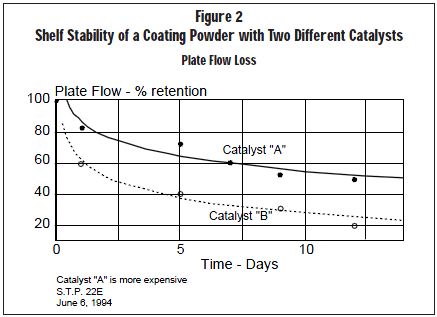Pulled from the Dexter Electronic Materials archives, this technical paper was written in April 1996 by Jim Glover, Project Leader
Abstract
 Many capacitors and resistors require an insulating coating after manufacture to protect against physical, chemical and electrical stresses. These components are often mounted on circuit boards and may be hermetically sealed in metal, glass or ceramic cases. A majority of the units are insulated with an organic polymer which is easier to apply and can be more cost effective. The insulation may be supplied as a one or two component liquid polymer, or in many cases, molded by either a transfer or injection process. Another fast and economical process is to apply a powder coating to the finished units.
Many capacitors and resistors require an insulating coating after manufacture to protect against physical, chemical and electrical stresses. These components are often mounted on circuit boards and may be hermetically sealed in metal, glass or ceramic cases. A majority of the units are insulated with an organic polymer which is easier to apply and can be more cost effective. The insulation may be supplied as a one or two component liquid polymer, or in many cases, molded by either a transfer or injection process. Another fast and economical process is to apply a powder coating to the finished units.
Powder coatings may be applied via fluid bed dip, electrostatic deposition, or cascading. The insulating properties obtained are a direct result of the materials used in the formulation combined with the proper manufacturing procedures. The formulator has many raw materials at his disposal, which in turn offer a multitude of possibilities in a formulation. Some of these materials are relatively low in cost, while the prices of others continue to escalate.
This paper will describe the advantages of having the component designer working in consort with the coating powder manufacturer in the design phase. The optimally designed coating powder will have the best price vs. performance characteristics.
INSULATING MATERIALS
There are many types of insulating materials available for passive components. These include glass, metal, silicone, and organic coatings. Glass and metal encapsulation provides a hermetic seal but are very expensive. Silicones provide high temper¬ature service, but are also quite costly. The remaining insulated components are generally coated with organic materials such as waxes, paints, thermoplastics, or epoxies. Epoxies are thermo¬setting materials which can be applied as a liquid, molding powder, or powder coating. This paper will deal primarily with the design, manufacture, and usage of epoxy coating powders.
Epoxy coating powders are solid homogeneous mixtures which are finely ground to behave similar to a liquid during application. The powdered epoxy will fuse (melt) with application of heat and cure to a thermoset state. The cured coating provides electrical insulation and protection against many environments. Production rates in excess of 700 pieces per minute offer a low cost package. The economies realized are from a combination of coating powder costs, and the productivity and yields obtained.
A solid ISO 9001 quality system is a definite advantage in formulating a coating powder from the initial concept to the final commercialized product. These procedures guide the work to reduce the probability of future problems.
MATERIAL DESIGN
The component designer determines the specification his part requires and what the insulating material has to do. The following is a general formula or recipe for a coating powder.
| Resin | 50 |
| Hardener | 4 |
| Catalyst | 1 |
| Filler | 40 |
| Pigment | 1 |
| Additives | 4 |
| TOTAL | 100 |
There may be a need for moisture protection, thermal shock resistance, or flame retardancy. These are requirements for the cured film, but the material must also be applied to the parts. Consideration has to be made for the type of powder application equipment, line speeds and temperatures, powder storage, and waste disposal. With the component and powder designer working together, a coating powder with the best properties, price, and performance can be obtained. Table 1 is a list of properties that could be desired in an electronic coating powder.
RAW MATERIALS
Resin
The starting point for any coating powder formulation is the resin or resin blend. The most common, and lowest cost, is a reaction of epichlorohydrin and bisphenol A (bis A resin). This type of resin is available in different molecular weight ranges. Other resins are bisphenol F, novolac modified bisphenol A, epoxy cresol novolac, epoxy phenolic, biphenyl, etc.

Coating powders have a high resin demand to achieve good appearance. This may preclude the use of resins other than a bis A epoxy type for economic reasons, except as an additive or for high performance. Specialty resins will provide powders with a higher glass transition temperature, better high temperature properties, and better chemical resistance. After choosing the resin type needed, consideration has to be given to application of the powder. Resins come in a variety of softening points and melt viscosities and the resin or resin blend is chosen based on the maximum temperature the part or substrate can tolerate during the coating operation. Faster cure times and productivity is achieved by working at the maximum allowable temperature.

Hardener
The selection of a hardener for crosslinking the resin is based on the final properties desired in the cured coating. Hardeners such as amines, amides, anhydrides, imidazoles, Lewis acids, modified phenolics, and phenolics are all potential candidates. Anhydrides are generally used where high temperature properties are desired, while phenolics have superior moisture resistance. There are advantages and disadvantages to each type, whether it be price or performance, and no one hardener is best for all types of applications.
Catalyst
Catalysts are used to promote cure and there are many from which to choose. The proper selection not only has a bearing on the cure rate but on the final properties obtained. A low cost catalyst may give the desired properties, but may also provide poor shelf stability as seen in the figure 2.
Filler
The next main ingredient to consider is the filler or extender. Fillers are incorporated into coating powders to provide properties such as higher thermal conductivity, lower coefficient of thermal expansion (CTE), lower gloss, improved flammability ratings, lower cost, etc. There are a number of different types of fillers that can be successfully used in coating powders, and there are advantages and disadvantages with each of them. It is important to use the proper amount of filler in a coating powder. Many problems arise when too much filler is used, such
as poor flow out, poor fluidization, and poor strength. Table 2 lists advantages and disadvantages with several types of fillers used in coating powders.

Pigment
Most coating powders are pigmented to give them an identifying color. Pigmentation is also used to enhance laser marking where desired. Pigments used in electronic grade coating powders are chosen with great care. Some of the best pigments from the recent past are no longer being used because they contain heavy metals. Pigments without heavy metals can cost more than ten times as much as their predecessors.
Additives
A number of component manufacturers prefer to have coatings that have a degree of flame retardancy built in. Materials generally used consist of a halogenated polymer combined with antimony oxide, aluminum trihydrates, and phosphorous containing compounds. These materials while contributing to flame retardancy do little else to enhance the properties of a coating powder and often times create problems as shown in the following:
| Effect of Antimony Oxide on Moisture Performance | ||
| % Antimony Oxide | 1.27 | 0 |
| Percent Failures | 48 | 10 |
| Tested in pressure cooker, 132 hrs | ||
Lastly, most coating powders will contain a silane or wetting agent to promote adhesion to the substrate and improve wet physical strength. Only through design of experimentation can the proper type and amount of silane or wetting agent be determined. Figure 4 shows the enhanced effect of selecting a better silane for moisture performance.

APPLICATION EQUIPMENT
There are many different methods for the application of coating powders to electronic substrates including dipping, cascading, and electrostatic deposition. Each method may require a modification to the coating powder to handle properly. One of the most common machines for coating electronic parts is a large automated fluidized bed where the parts are placed on carrier strips and preheated to 100–175°C. After preheating the parts, the air to the fluidized bed is reduced and the powder is scraped flat to produce a level surface. The parts are dipped in the powder for 1–3 seconds and removed for reheating to melt the powder. Several dips may be required to achieve the proper coating thickness. A final post cure is given to the coated parts to achieve the desired properties. The levelness of the powder in the machine will determine the pant leg height which can be held to 15 mils in many cases. Pant leg is the amount of powder over and above the component on the leads. This has to be kept at a minimum to prevent problems with soldering.
Coating powders may also be applied by electrostatic deposition. The substrate is attached to a ground or neutral potential while ionized air charged to 40–80kV is used to fluidize the coating powder and form a cloud over the bed. The substrate is passed through the cloud attracting the charged particles. Uniform coating thicknesses from 2–20 mils are obtained in this manner. After
coating, the powder can be selectively removed from unwanted areas. A final postcure for 30 minutes at 100–200°C finishes the process.
A third method of applying coating powders to components is the cascade or wheel coating method, where axial or radial devices are handled equally well. Reeled parts travel along a conveyor and pass through a preheat stage to raise the part temperature sufficiently for coating. Powder is cascaded or poured on a wheel where the parts pass through. A typical set up will have from one to four wheels for powder application with reheating zones in between. The additional wheels are for increased coating thickness or possibly a different powder, depending on the application.
Additional heating takes place at this point to provide an adequate cure, either on line or in a batch type oven.
COATING POWDER PROCESSING
Coating powders are generally made in a batch type process. Quality approved raw materials are weighed according to the formula and placed in a blender to achieve a uniform mixture. The blended material is passed through an extruder or melt mixer to obtain a homogeneous compound. The resins used in compounding are solid at room temperature requiring the melt mixer to be at an elevated
temperature (75–125°C) for adequate processing. The extrudate is cooled to room temperature, pulverized, sieved to desired particle size, quality tested, and packaged for shipment.
An important design criteria is the particle size distribution of the coating powder. The method of application of the powder dictates the grind profile requirements. Fluidized bed and cascade
coatings need a relatively coarse grind size, i.e. 100% finer than 177 microns (80 mesh) and 35% finer than 44 microns (325 mesh). Ideally, all particles finer than 5–10 microns are removed for two
reasons. Fines in a powder can coat out on leads of devices making soldering difficult. Secondly, fines in a powder are a possible respiratory and housekeeping problem.
CONCLUSION
Coating powders perform an important function in the insulation of passive electronic components. The ideal insulation is one that is designed with the component manufacturer and the coating
powder supplier working together to formulate a product that meets all of the necessary requirements. A good partnership will provide the optimum product for the least cost where all parties can be winners.
For more information about Epoxy Coating Powders or any other of our products, visit us or contact us for more details. Please click here for the list of technical datasheets.

